V. An Aspect of Minor/Major Significance
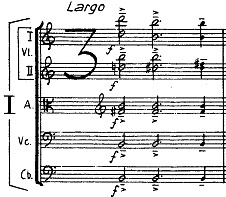
Thus
far Martinů’s approach to harmony
has been obliquely addressed in the
course of studying other aspects of
his music. With regard to the composer’s
use of traditional tonal structures,
however, one aspect stands out as especially
salient and merits special attention:
the employment of opposing major and
minor modes. The passage quoted above
that opens the Largo
of Martinů’s Double Concerto for
two string orchestras, piano and timpani
(1938) shows this minor/major paradigm
in seminal form. It is highly significant
that Martinů, in what must surely
be one of his most harmonically complex,
emotionally turbulent works,
has employed this simple gesture as
a powerful symbol of triumph over struggle.
As if to underscore this message of
hope, the two chords return to cap the
entire work.
In the slow movement of the String
Quartet No. 5 written earlier in the
same year, the minor/major progression
above is reversed. The opening of this
movement was discussed as a kind of
pessimistic pastoral in chapter three,
with a lonely octatonic tune in the
first violin accompanied by shuddering
tremolandi and fatefully "knocking"
staccato notes. In the final measures
shown below, the music achieves a longed-for
peace with a comforting violin solo
full of repose, accompanied by sighing
chromatics. After a breath of silence
a cadence on a hopeful C major follows
reassuringly, openly harmonized for
a feeling of maximum restfulness. But
this arrival in paradise is cruelly
disturbed by col legno notes
in the viola already heard at the beginning
of the movement, and the harmony slips
into the parallel minor, ending the
movement on a tragic note:
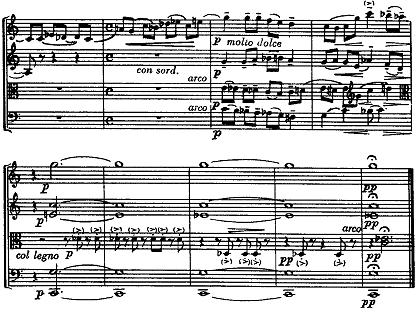
The following more extended passage
from the Field Mass (1939) provides
an opportunity to expound further upon
this theme. This work, completed just
after the outbreak of World War II,
recalls the fervent patriotism of the
1918 Czech Rhapsody. Its musical
style is more restrained, however:
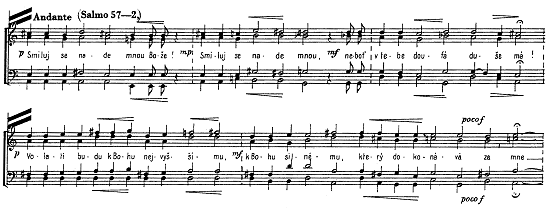 (Translation:
Be merciful unto me, o God! Be merciful
unto me, for my soul trusteth in thee!
I will cry unto God most high, unto
God almighty, that performeth all things
for me. -Psalm 57:2)
(Translation:
Be merciful unto me, o God! Be merciful
unto me, for my soul trusteth in thee!
I will cry unto God most high, unto
God almighty, that performeth all things
for me. -Psalm 57:2)
This self-contained passage
features an interesting series of chord
progressions, employing major and minor
triads in a subtle manner that deepens
the meaning of the text. As the passage
unfolds, the conflicting emotions of
the speaker are immediately sensed.
Martinů’s
setting reflects the pleading and hopeful
character of the words, while acknowledging
underlying doubts and fears. The harmony
begins with an A-major chord and concludes
with a triad in the parallel minor -
an overall progression that is mirrored
in the individual phrases.
“Smiluj
se nade mnou, Bože!” (Be
merciful unto me o God!) begins hopefully
in major but unexpectedly darkens with
a downward move to E minor. The second
phrase operates similarly, but with
a more adventurous non-functional progression
of major triads (A-C-E-B). Here Martinů
employs a crescendo
and the prayer
becomes more insistent, repeatedly asking
for mercy; but the phrase again descends
to minor (a more haunting chromatic
descent in the upper voices, compared
to the previous whole-step descent).
Now the minor coloration takes over
in the ensuing phrase, "nebot’
v Tebe doufá duše má!"
(For my soul trusteth in thee!), until
a final upward move back to the original
A major seems to confirm the speaker’s
hopes, despite the doubtful intrusions
of minor chords. The music has come
full circle, not having progressed anywhere
after all. Indeed, the ambiguity between
the tonal centers A and D, evident at
the beginning of the passage, plays
itself out in the third phrase, which
concludes in A major after suggesting
D minor.
In hindsight it is clear
that this opening half serves to lead,
like a large gestural upbeat (notice
the fermata), to the sustained D major
passage that follows. Here, the chorus
of soldiers is describing an action,
crying out to God, and expecting that
He will answer the prayer. There is
more of a sense of motion here due to
the extended quarter-note motion and
the unexpectedly functional harmony.
Rather than the static quality of the
first line, where phrases were punctuated
by rests, the three phrases here are
more continuous and the boundaries consequently
blurred. Interestingly, despite the
more animated setting the passage begins
with piano
dynamics, muting the determined nature
of the text. Martinů seems
interested in creating subtle musical
effects that add dimension to the chorus’
relationship to the sung text as well
as the meaning communicated to the audience.
The word "nejvyššimu"
(most high), which ends the first phrase,
uses the minor-major progression
in a quintessential word-painting gesture.
The second phrase begins on the same
chord (Martinů did this at the
beginning of the excerpt as well) but
then departs with a new progression.
The second arrival at the syllable “-mu”
gives us an unstable
6/4 chord instead of the earlier root
position, and at this point D major
begins to lose its hold on the passage.
An unexpected C-major chord ushers in
a modal progression reminiscent of the
first part as the music begins to come
full circle.
The text promises a confident
conclusion to the passage but the music
resolves in a forceful Dorian cadence
on A minor. It is easy to see the reason
for the change, which not only sums
up the entire passage but also prepares
for what follows beyond the excerpt:
the baritone solo laments his dire situation
in a new passage excerpted from Psalm
56: "Mine enemies would daily swallow
me up, for they be many that fight against
me, o thou most high!" There is
a spontaneous quality to the entire
passage as it sensitively unfolds from
moment to moment, but this is balanced
by apparent large-scale
planning. Martinů’s symbolic use
of minor and major chords enhances the
meaning within in a setting closely
reliant upon traditional tonal harmonic
procedures.
The
minor/major dichotomy is also played
out in ways evidently touched by Martinů’s
responsiveness to
more modern trends. There is often a
distinctly more playful quality to such
examples, which is not surprising given
the lighter side of the composer frequently
observed elsewhere in this study. One
such example wittily recalls the world
of Bach’s fifth Brandenburg Concerto.
Below is the opening ritornello from
the finale of the Concert pour trio
(1933) for piano trio and string orchestra,
and the first three measures, in A major,
are delightfully untroubled in their
diatonic clarity: 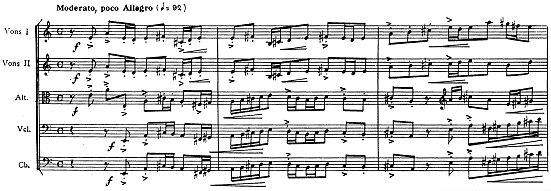
In the fourth measure the music abruptly
shifts to the parallel minor, which
ushers in further destabilization; an
equally abrupt modulation to D-flat
major ensues, followed by increased
chromaticism. A few deliberate "wrong-note"
clashes increase the dissonance but
prove short-lived as the music simply
- and again abruptly - cadences on C
major, far from its harmonic point of
origin:
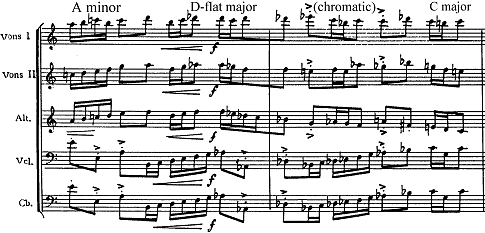
With
this obvious reference to Bach Martinů
once again parodies an older style while
at the same time bringing it up to date
in typical neobaroque fashion, and the
use of parallel minor as a quick springboard
to uncertain terrain seems particularly
clever.
Martinů
works along similar lines in two examples
from another work from this period at
least partly inspired by Bach, Les
Ritournelles
for solo piano. The austere beauty of
the following cadence from the Loure
of the Bach’s Fifth French Suite owes
much of its character to the dissonant
counterpoint in the quarter notes of
the penultimate measure:
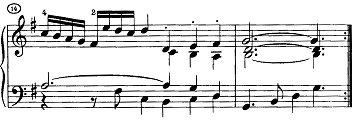
Martinů
builds upon this type of cadential gesture
in his Intermezzo
No. 2 from Les
Ritournelles. The dissonance in
the last beat of the first measure is
reminiscent of the Bach example, again
the product of a step-wise moving bass
line. A seemingly logical progression
towards a cadence, however, is sidetracked
in the third measure by nonfunctional
major and minor chords that lead abruptly
to the arrival on E (minor). This tentativeness
is foreshadowed by the slide from C
minor to C major in the first measure
of the excerpt. The music seems to be
groping, blindly searching for an appropriate
cadence. In that sense it differs markedly
from the inevitable structure of the
Bach, but shares something tangible
from its sound world nevertheless:
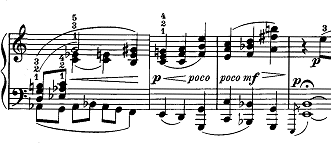
In the introduction to
the first movement of the same work,
minor/major conflict is played out in
successive broken triads. The disagreement
becomes vertical as the passage culminates
in a clash between major triads (some
with added sevenths) and an outlined
d-minor chord in the bass (an augmentation
of the beginning of the movement).
The right hand progression, typical
of Martinů, is based on a pattern
clearly influenced by the topography
of the keyboard:

Similar vertical clashes occur in the
following additional examples. In the
finale of the String Quartet with
Orchestra (1931) a cheerful polka
tune in the solo first violin is diatonic
and in major mode, but the second violin
and viola add mocking flatted thirds
to the triads of F and B-flat. Interestingly,
these never occur simultaneously but
instead create playful cross-relations:
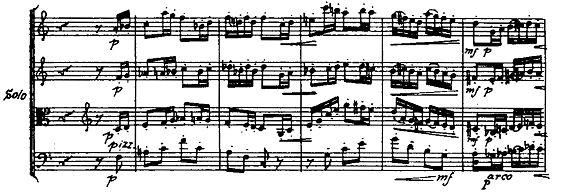
Harsher in quality is the opening of
the Partita (Suite No. 1) of the same
year for string orchestra, which begins
with a cheerful, breezy pentatonic theme
in C. This is rudely interrupted by
the lower strings’ brusque C-minor chords,
embellished with added notes for a denser,
more abrasive effect within the piano
dynamics:
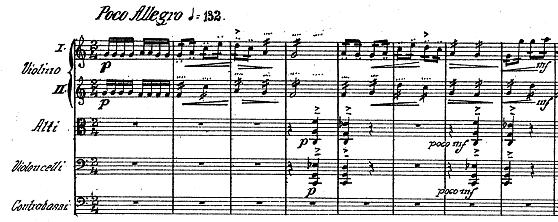
These
last two examples show the major/minor
idea expressed within a stylized folk
setting, something Martinů probably
learned from Dvořák’s memorable
use of this device in his folk-oriented
works. Equally relevant, however, is
the influence on Martinů of jazz.
Its enlivening effect upon Martinů’s
rhythmic palette has already been explored,
but the blues, with its characteristic
tonal inflections, proved equally stimulating
to the composer’s
creative imagination. Perhaps the best
place to begin in this case is at the
beginning. The first work to explicitly
reference the blues style is the first
of the composer’s Trois esquisses,
a short movement marked Tempo di
Blues. This "first
contact” shows a humorous treatment
of the blues scale. Martinů simply
introduces all the blue notes at once
in one chord, alternating back and forth
between natural and blue notes in a
syncopated rhythm. Meanwhile the left
hand proceeds in the farthest
possible key while also featuring a
bluesy oscillation between perfect and
diminished fifths. There could not be
a more obvious pronouncement of the
piece’s intentions, and Martinů
delights in this anti-subtle approach:

Such alternations soon
give
rise to a peculiar mannerism in Martinů’s
music, the wedding of blues inflections
to the secondary ragtime pattern. Here
are two typical examples. The first
is from Le Départ,
and the second from the finale of the
Violin Concerto No. 1:
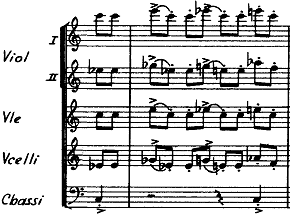

Less clichéd
is the following example in which the
minor/major gesture is blended with
other contrasting elements. It is an
episode taken from the slow movement
of the String Quintet, where Martinů’s
layering technique is visually very
apparent. The first violin has
a typical melody built from two pairs
of oscillating notes treated in succession.
Chromatic lines in three of the other
instruments add to the mournful effect.
The first viola seems to have relative
unimportance until the blues motive
appears (minor-major-minor thirds),
in an apparent effort to break free
from the gloom that surrounds it. The
effect is equivocal since this tonal
ripple, while providing a kind of musical
commentary, has not affected any real
expressive change:
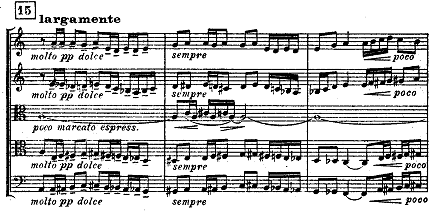
The blatantly bluesy pieces,
of which there are in fact quite a few
from the late 20’s, give way to the
more sublimated use seen in the example
above. A parallel trend was observed
when examining the rhythmic repercussions
of Martinů’s exposure to jazz.
A good example of this less
pronounced approach occurs in the first
movement of Fenêtre sur le
jardin,
a cycle of four piano pieces written
in 1938 at the cottage of Martinů’s
mother-in-law at Vieux Moulin, just
outside of Paris. Here, in a moment
of repose and apparently inspired by
the picturesque flower garden surrounding
the house, Martinů wrote this charming
work and dedicated it to one of his
well-to-do Czech patrons living in Paris,
Helene Pucová. At the time, though,
he was separated from his beloved pupil
Vítĕzslava Kaprálová
and this is reflected in the wistful
nature of the first movement especially.
In the opening, amidst very colorful
sonorities, there is an unmistakable
reference to the blues, which Martinů
was quite literally feeling at the time:

The blues element
blends seamlessly with other added-note
chords. Thirds and sixths dominate the
entire passage, favorite earmarks of
Martinů’s folk style, but blue
and other added notes essentially obscure
this aspect. Similarly, the added notes
that frequently complicate
his settings of simple folk-like tunes
have an altogether different effect
here, too, as the impression is one
of subtle colors blending in a very
"French" style.
In the "B" section of the
work the pitches of F-sharp, F and D,
which represent the essence of the piece
so far, become a bluesy, swirling accompanimental
figure, clouding the D-major quality
of the passage as a whole. Here, harmonic
piquancy is added as the right hand
part, based upon a similar pattern,
overlaps in such a way that the F and
F-sharp clash directly:

The entire cycle has a naïveté
and sense of vulnerability pointed out
elsewhere in Martinů’s output,
but this work stands out especially
considering the fact that after completing
it he set to work immediately on the
fierce and unrelenting Double Concerto.
But if the two neighboring works are
worlds apart on the expressive plane,
a similar melodic structure can be observed
at the micro level. For the lamenting
melody that emerges from the tense,
rhythmic opening of the Double Concerto
employs the same pitch classes as the
accompaniment figure in Fenêtre
sur le jardin, but the harmonic
context of the blue note here is D minor
(flatted fifth) instead of D major (flatted
third). When the melody ascends back
to the A natural, the intervallic sense
is more like an augmented second, giving
this melodic lament an exotic flavor:

An equally curious connection to Fenêtre
sur le jardin occurs in the Field
Mass written the following year.
The somber chord that opens the piece
contains the exact same collection of
pitches as those in the first beat of
Fenêtre sur le jardin,
arpeggiated together. The result is
a coloristic chord simultaneously (or
nearly) sounding both minor and major
thirds, with the timbral color enhanced
by the instrumentation. Once again the
reference to the blues reflects the
uncertain and painful times in which
the work was written:
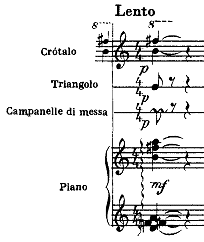
The
excerpt from the Double Concerto cited
at the beginning of this chapter sums
up Martinů’s fascination generally
with this material, and the gesture
itself might be a metaphor for the positive,
humanistic art that the composer pursued
throughout his years in Paris. It is
no coincidence that when Martinů
was commissioned to write a symphony
by Koussevitsky shortly after his arrival
in America, the composer resorted to
a very familiar gesture for the opening
bars of his newest wartime work: a simple
progression from B minor to B major.
Introduction
I.
A New Beginning: Life In Paris
II.
How Martinů "Got Rhythm"
III.
Of Folk Tunes, Pastorals, and the Masses
IV.
Dvakrát Svatý Václave
(St. Wenceslas, Twice)
V.
An Aspect of Minor/Major Significance
VI.
Fin de séjour: Julietta
and Musical Symbolism
VII.Conclusion:
Martinů’s Parisian Legacy

